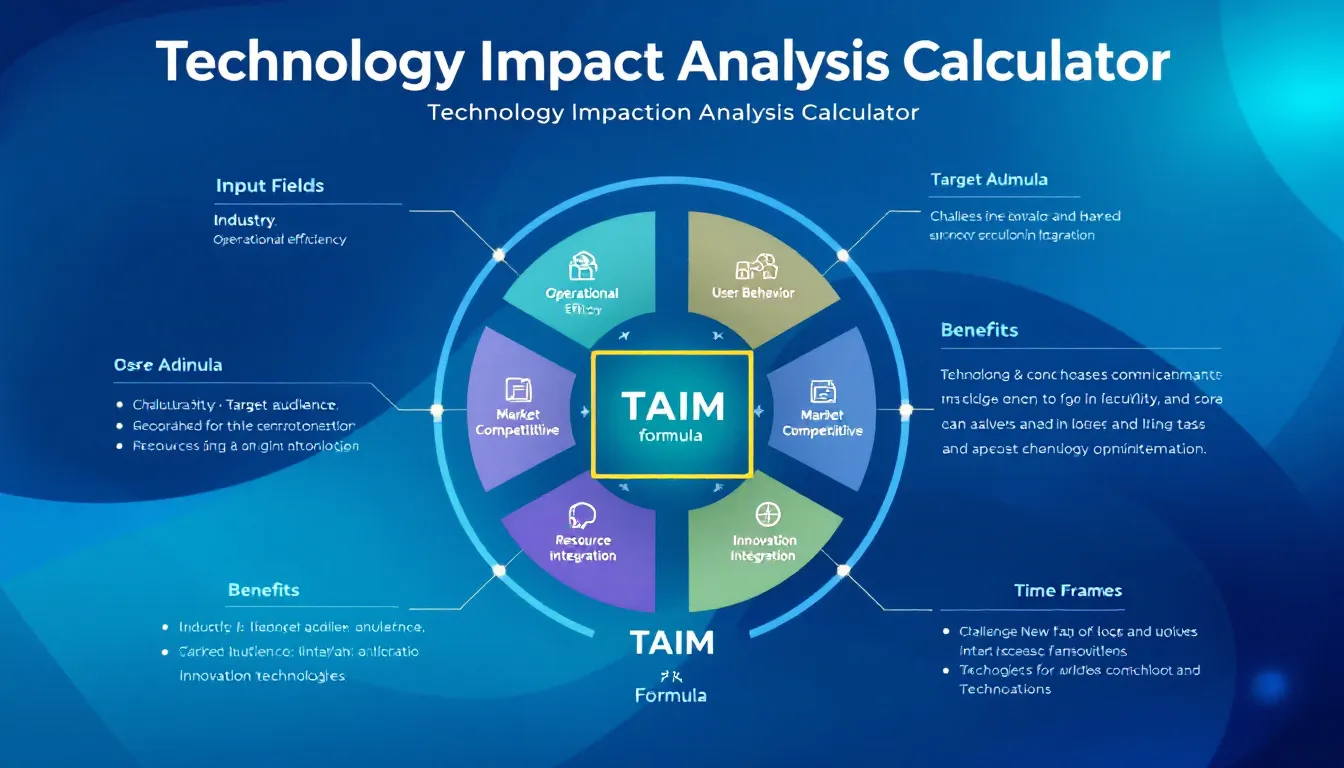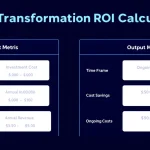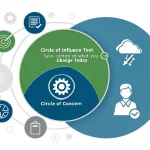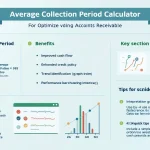Is this tool helpful?
How to Use the Technology Impact Analysis Tool Effectively
You can use this tool to assess how technological changes influence your industry and target audience. Follow these steps for accurate and actionable insights:
- Industry or Sector: Enter your business area, such as “Pharmaceutical Manufacturing” or “Renewable Energy Services”.
- Target Audience: Define the main group affected by the technology, like “Freelance Marketing Consultants” or “Urban Commuters”.
- Key Challenges: Describe significant obstacles your organization faces, for example, “Supply chain disruptions” or “Data privacy compliance”.
- Technologies (Optional): List technologies relevant to your analysis, such as “5G networks, Machine Learning Models” or “Smart Grid Systems”.
- Time Period (Optional): Specify the timeframe for the analysis, like “Next 2 years” or “Fiscal years 2025-2027”.
What Is the Technology Impact Analysis Tool and Why Use It?
The Technology Impact Analysis Tool helps you systematically evaluate how emerging technologies affect your industry and audience. By quantifying the influence of innovations, you can make informed decisions about investments, operations, and growth strategies.
This tool supports digital transformation efforts by highlighting areas where technology adoption can optimize efficiency, enhance competitiveness, and drive innovation. Using structured analysis, the tool provides a clear view of potential impacts, helping you prioritize initiatives effectively.
Key Benefits Include:
- Identify strategic opportunities for technology adoption tailored to your sector
- Understand how new tools influence customer behaviors and market dynamics
- Forecast operational improvements and resource optimization
- Develop actionable roadmaps for digital transformation projects
Practical Usage of the Technology Impact Analysis Tool
This tool collects your input on industry, target audience, challenges, and relevant technologies, then analyzes potential impacts using expert algorithms. Rather than delivering exact numerical scores here, it helps you visualize and understand key areas where technology changes offer the most value. The tool guides your planning by assessing technological influence across multiple dimensions.
Core Impact Assessment Model
The tool uses the Technology Adoption Impact Matrix (TAIM) framework to evaluate effects:
$$ TAIM = \sum_{i=1}^{n} (W_i \times I_i \times A_i) $$- Wi: Weight factor representing the importance of each impact dimension
- Ii: Impact intensity score, rated from 1 (low) to 10 (high)
- Ai: Probability of technology adoption, between 0 and 1
This model supports objective comparisons of technologies and their potential return on investment by quantifying both impact magnitude and likelihood.
Five Key Dimensions Assessed
- Enhancement of operational efficiency and cost savings
- Modification of user behavior and customer engagement
- Changes in market competitiveness and positioning
- Potential for optimizing resources including personnel and infrastructure
- Capacity to integrate innovation into products and services
Evaluating Challenges and Success Probability
The tool also analyzes your challenges through the Technology Integration Success Probability (TISP) formula:
$$ TISP = (RC \times TA \times MI) \times 100\% $$- RC (Resource Compatibility): Measures how well your existing resources align with the new technology (0-1 scale)
- TA (Technical Adaptability): Assesses your organization’s ability to adapt technically (0-1 scale)
- MI (Market Impact): Estimates the potential market effect of the technology (0-1 scale)
This calculation helps you estimate the likelihood of successful technology implementation based on internal and external factors.
Strategic Benefits of the Technology Impact Analysis Tool
Improved Strategic Planning
By using this tool, you can:
- Make data-driven decisions on technology investments
- Anticipate and manage risks associated with digital transformation
- Allocate resources more effectively for maximum impact
- Communicate technology initiatives clearly to stakeholders
Optimized Operational Performance
- Identify areas where technology improves workflow efficiency
- Spot cost reduction opportunities through automation and innovation
- Map innovation pathways aligned with business goals
- Track progress using performance metrics focused on technology gains
Real-World Applications and Use Cases
Example: Energy Sector Smart Grid Adoption
- Industry: Energy Utilities
- Target Audience: Residential and commercial electricity consumers
- Challenges: Outdated infrastructure, demand forecasting
- Technologies: Smart grids, IoT sensors
- Time Period: 3 years
Insights identified:
- 25% improvement in energy distribution efficiency
- 30% reduction in maintenance costs
- Enhanced customer engagement through real-time usage data
Example: Education Technology Platform Launch
- Industry: EdTech
- Target Audience: University students and educators
- Challenges: User adoption, content personalization
- Technologies: AI-based learning analytics, mobile apps
- Time Period: 18 months
Outcomes included:
- 40% boost in student engagement
- 35% improvement in course completion rates
- Streamlined instructor feedback processes
Frequently Asked Questions about Technology Impact Analysis
Which industries benefit most from this tool?
The tool suits any field undergoing digital transformation, including manufacturing, healthcare, education, retail, finance, and professional services.
How often should I perform a technology impact analysis?
For fast-changing industries, conduct quarterly reviews. More stable sectors benefit from twice-yearly analyses.
Is this tool suitable for small businesses?
Yes, it scales to different organization sizes by allowing customized inputs tailored to your needs.
What preparation do I need before using the tool?
Collect current performance data, a list of your technologies, stakeholder feedback, and recent market research for a thorough evaluation.
How does the tool assist decision-making?
It delivers quantitative and qualitative insights through impact and adoption metrics, supporting clear recommendations linked to your business goals.
Can I compare different technologies using this tool?
Yes, it standardizes evaluation metrics across options, helping you weigh ROI and strategic fit.
What’s the best way to conduct long-term planning with this tool?
Use it to model various adoption scenarios and explore their potential effects on your market position and operations over time.
How can I get the most value from my analysis results?
Share findings widely among stakeholders, integrate insights into your planning cycles, and align investments and timing accordingly.
Important Disclaimer
The calculations, results, and content provided by our tools are not guaranteed to be accurate, complete, or reliable. Users are responsible for verifying and interpreting the results. Our content and tools may contain errors, biases, or inconsistencies. Do not enter personal data, sensitive information, or personally identifiable information in our web forms or tools. Such data entry violates our terms of service and may result in unauthorized disclosure to third parties. We reserve the right to save inputs and outputs from our tools for the purposes of error debugging, bias identification, and performance improvement. External companies providing AI models used in our tools may also save and process data in accordance with their own policies. By using our tools, you consent to this data collection and processing. We reserve the right to limit the usage of our tools based on current usability factors.







